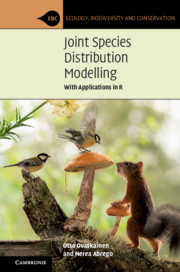Book contents
- Joint Species Distribution Modelling
- Ecology, Biodiversity and Conservation
- Joint Species Distribution Modelling
- Copyright page
- Contents
- Preface
- Acknowledgements
- Part I Introduction to Community Ecology
- 1 Historical Development of Community Ecology
- 2 Typical Data Collected by Community Ecologists
- 3 Typical Statistical Methods Applied by Community Ecologists
- 4 An Overview of the Structure and Use of HMSC
- Part II Building a Joint Species Distribution Model Step by Step
- Part III Applications and Perspectives
- Epilogue
- References
- Index
2 - Typical Data Collected by Community Ecologists
from Part I - Introduction to Community Ecology
Published online by Cambridge University Press: 18 May 2020
- Joint Species Distribution Modelling
- Ecology, Biodiversity and Conservation
- Joint Species Distribution Modelling
- Copyright page
- Contents
- Preface
- Acknowledgements
- Part I Introduction to Community Ecology
- 1 Historical Development of Community Ecology
- 2 Typical Data Collected by Community Ecologists
- 3 Typical Statistical Methods Applied by Community Ecologists
- 4 An Overview of the Structure and Use of HMSC
- Part II Building a Joint Species Distribution Model Step by Step
- Part III Applications and Perspectives
- Epilogue
- References
- Index
Summary
This chapter describes the types of data that empirical community ecologists typically collect, and how these can be incorporated in the Hierarchical Modelling of Species Communities (HMSC) framework as input. While community ecologists apply theoretical, experimental and observational approaches to studying the processes that structure ecological communities, this chapter (and the entire book) focuses mainly on empirical research based on non-manipulative observational data. Understanding the basic features of the data and how they have been collected will be essential for appropriately setting up the HMSC model and interpreting the results. The chapter describes each type of input HMSC data, namely the community data (i.e. the occurrences or abundances of the species), environmental data, data describing the spatio-temporal context, species trait data and phylogenetic data. Finally, the chapter discusses how to best organise the data, as well as how to solve problems arising from missing data.
Keywords
- Type
- Chapter
- Information
- Joint Species Distribution ModellingWith Applications in R, pp. 19 - 29Publisher: Cambridge University PressPrint publication year: 2020

